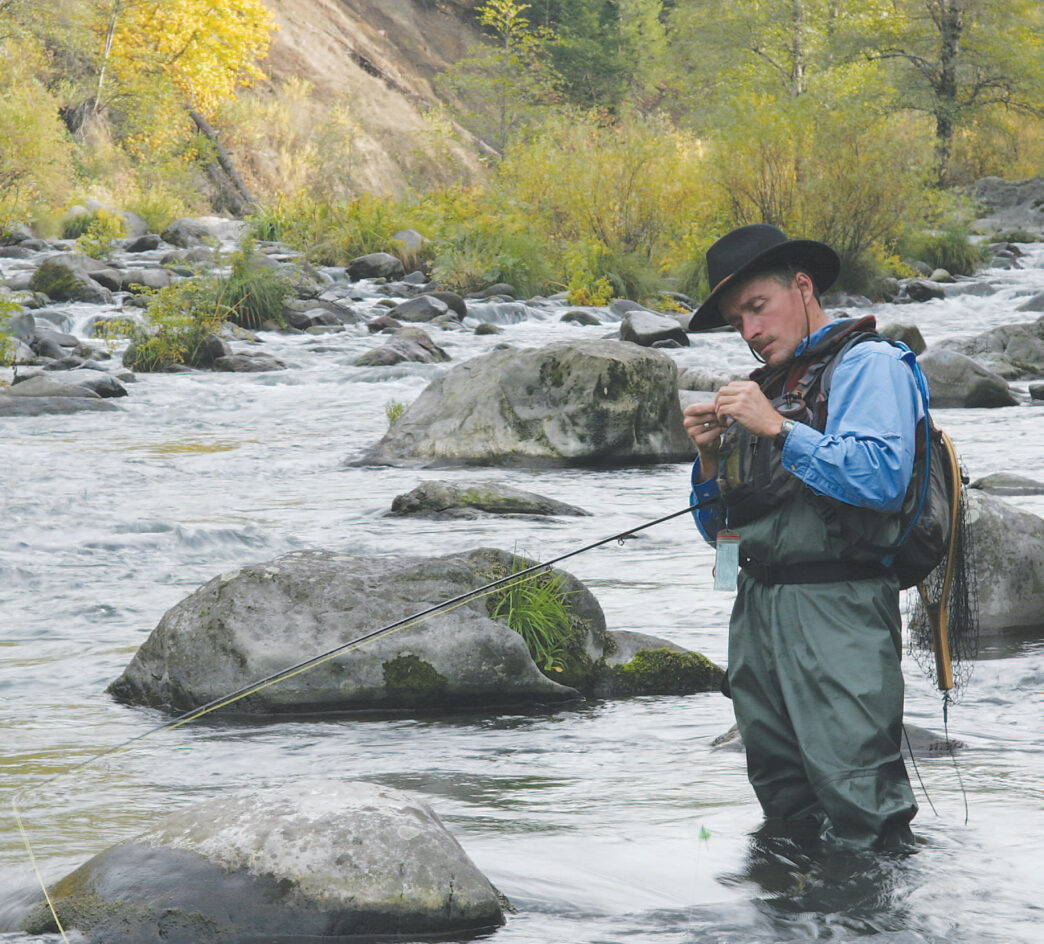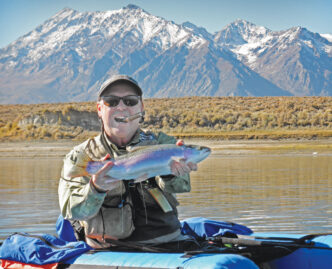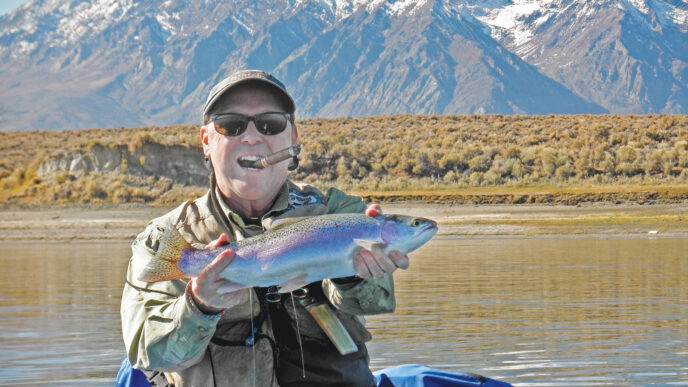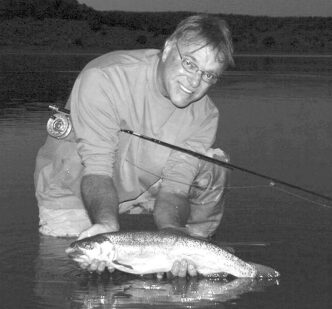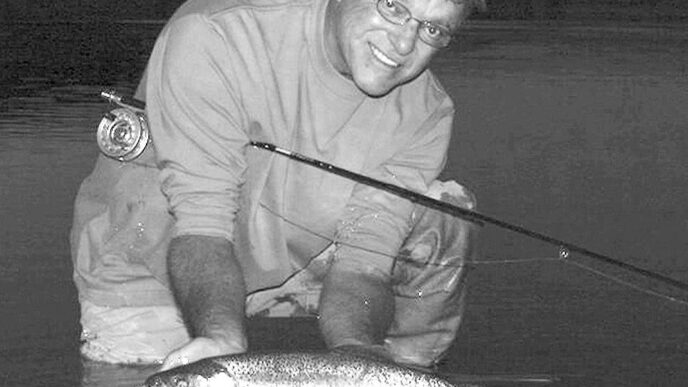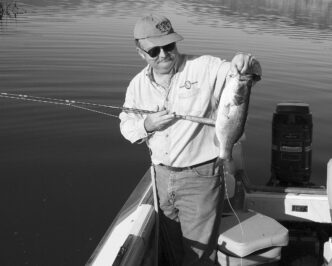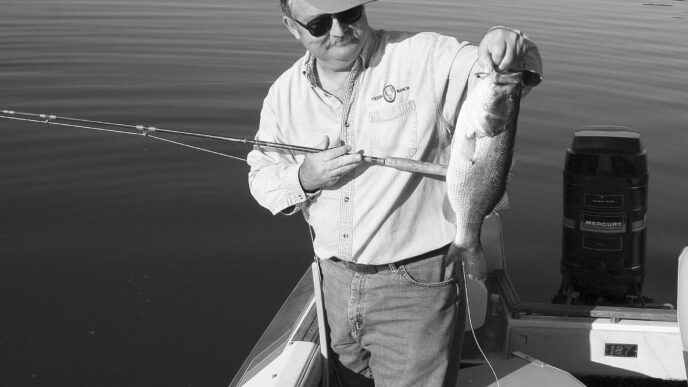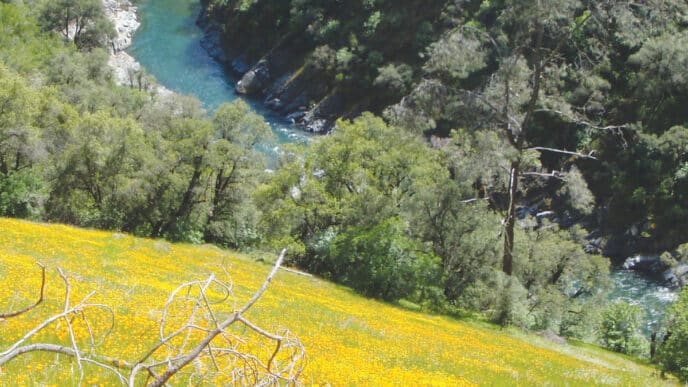As I sit on the bank of the South Fork Snake River on a warm, breezy summer Idaho day, it is a bit difficult to imagine a time this fall, just a whisper away, when I will view my breath forming in front of my face in the canyon of the McCloud as I cast an October Caddis dry to a visible rise or expectantly swing a Muddler across a promising glide for elusive steelhead on the Klamath. The leaves will have turned golden or a brilliant red, along with the elephant ears on the local freestones, and columns of geese will form long lazy Vs overhead on their way to warmer climes.
Summer fish on the Snake River this week have been feeding as if they were teenagers devouring a pizza. Fall trout and steelhead in the streams in the shadow of Mount Shasta are often more discerning, acting as if they are fine diners at a fancy restaurant, enjoying a bit of reflection before they sample their next morsel. They’ll rise, only to bump the fly, as if to say, “Send it back. It’s not quite ready to eat.”
Choosing a fly in the fall may be a more important factor for angling success than in any other season. Gone is the greedy feasting of spring and summer. Gone is the high, off-color water to help disguise your approach, sloppy casts, and inaccurate patterns. We’ve enjoyed the spring and summer months and taken the opportunity to refine our technique and tactics. Now fall is the time to put it all to use. While proper presentation remains paramount, by the time fall arrives, trout have seen it all, and they will more frequently refuse a fake. The first runs of steelhead also arrive in Northern California rivers, having run a gauntlet of flies on their journey from the coast, so offering a unique pattern that still stimulates a grab can often represent the difference between a satisfying outing and one marked by disappointment.
Nearly fifty autumns have passed since I first cast a fly, and my fly selection has matured over the years. I now take some time to sort out my summer seasonal flies and replace them with fall favorites, five of which I will review. The flies I most often employ are similar to those that others use, but mine often feature a little tweak or technique that sets them apart.
Morrish’s October Caddis
The October Caddis is the most anticipated hatch in the fall in Northern California. The bugs are large, size 8 on most rivers, and provide trout with the last big meal before winter sets in on local streams, so October Caddis imitations should be in every trout angler’s autumn fly box. They also can be used to draw strikes from steelhead, which perhaps recall feasting on these morsels before migrating to feed on even larger fare in the salt.
For almost every fall season until recently, I relied on the Sofa Pillow as my go-to dry fly to represent the October Caddis. This was a pattern similar to Randall Kaufmann’s now much more popular Stimulator, but it antedates it. The Sofa Pillow is typically a bit more heavily hackled and traditionally was tied in a rusty brown orange color, rather than the rainbow of colors now offered in the Stimi. Both the Sofa Pillow, which I still carry, and the Simulator manage to catch a significant number of fish in the fall as October Caddis dry-fly imitations.
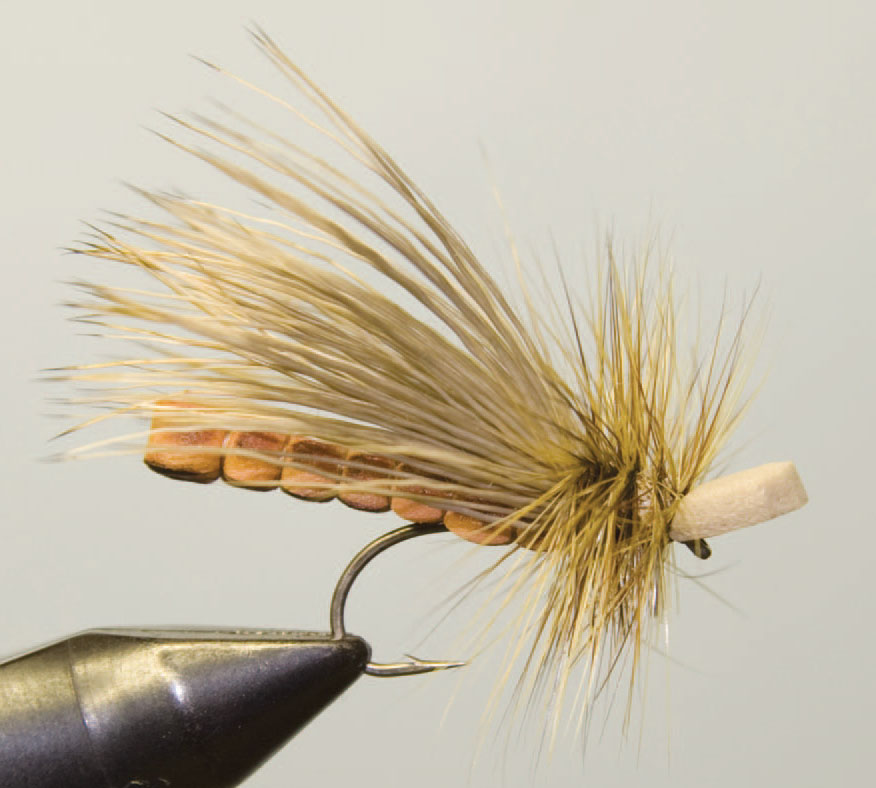
Morrish October Caddis
Hook: Tiemco 100, size 8
Thread: Black 6/0 Uni-Thread
Rib: Black thread
Body: Orange 2-millimeter foam
Wing: Stacked elk hair
Nose: Tan 2-millimeter foam
Legs: Brown hackle, clipped on bottom, thorax style
However, I have recently switched to a new favorite: Ken Morrish’s October Caddis. I’ve done so for a very simple reason — I catch more fish. It is a no-fuss pattern that employs an extended foam body that floats high and long and a heavily hackled forward portion that allows anglers to bump, skitter, skate, and dance the fly across the river, much like the naturals. Many anglers have described their frustration to me in trying to get trout to eat a dry fly during the October Caddis hatch. While Kenny’s pattern has increased my success, how I fish his pattern has improved it much more. The first important consideration to understand is that many more fish are eating egg-laying October Caddises than hatching winged insects. The bugs most often crawl to the shallow, still margins of the river to pupate and hatch, which is not often were trout prefer to hold in order to feed.
If you observe the egg layers, you might notice that they most often dip and dive to the surface to drop their eggs, becoming available to the fish for only a split second before taking off to dip and dive again. As they tire, they sometimes stick to the surface for a longer period, but rarely attain the long, still drift of a mayfly through a glide as it dries its wings in preparation for takeoff. However, most anglers cast their October Caddis dries as if they are fishing a mayfly hatch, with long, drag-free drifts through classic runs. They also cast well upstream from fish they observe rising, presumably to avoid spooking the fish and also perhaps to adjust the alignment of their drift. This technique will at times catch trout, including some large ones, but rarely does it catch many.
Like others, I cannot resist offering my October Caddis to fish in the heart of the classic runs that produce so well during a mayfly hatch. However, I rarely set up shop in the run and fish to rising trout until they no longer show, as I do for mayflies. Most often, if I am fishing a run like this with an October Caddis dry fly, I am using it as an indicator fly in a “dry, copper, dropper” rig to nymph the run and am pleasantly surprised when a fish eats my caddis bobber fly.
To assemble that rig, I typically keep the leader short, 6 to 7 feet of 4X, with the first beadhead dropper (often a pattern with a wire body, such as a Copper John or Iron Sally) tied with 20 to 30 inches of 4X off the bend of the October Caddis hook. I then tie the second dropper off the bend of the first dropper with 9 to 15 inches of 5X. I fish the shortest leader and tippet lengths possible to get the depth and manage the stealth I am after, because I find a short leader much easier to cast while avoiding tangles. I also cast the shortest line possible, trying to keep an open loop. I enjoy more success when I move and constantly adjust my position to get as close as possible to the fish, rather than lengthening my line to cast with my feet planted.
Which brings me back to the point that the best dry-fly water for fishing October Caddis dries is probably not the same run where you enjoyed a magical summer evening casting tiny dries to sippers during a mayfly hatch. Short, choppy, broken-up runs and pocket water is what I most often target when fishing October Caddis dries. I prefer to stay on the move, casting to likely holding spots, rather than looking for risers. If I do see a fish rise, I try to hit it on the head, just a foot or two upstream from the rise form. The fly landing on the water is what most often triggers the strike. Because the egg-laying adults touch and go, fish learn to strike when the bug first lands and to ignore bugs that are far from their lies, knowing those bugs likely will fly off before drifting within range. After my fly drifts four to six feet, or at the most eight, I usually pick up and cast again, trying to land the fly on the spot where I believe a fish is holding, rather than dead drifting it down to the fish’s suspected lie.
When I fish the October Caddis dry alone in broken water like this, I prefer to use a 7-1/2-foot 4X or 5X leader. This allows me to bump the fly when it enters the prime zone to help it look alive, as well as to skitter and skate it to elicit strikes. If the fishing action is slower than I can stand, I add a small tungsten beadhead nymph dropper 20 inches or so off the bend. The beadhead droppers I most often fish are Pheasant Tails, Bird’s Nests, Hogan’s S&Ms, Two Bit Hookers, Morrish’s Iron Sallies, Copper Johns, and my favorite fall beadhead nymph, Mike Mercer’s Micro Mayfly, which I’ll discuss next.
Morrish’s October Caddis also has served well on occasions for early run steelhead, particularly when the fish have arrived in low, clear water. I nymph the same way I do with a dry, copper, dropper rig as described above, but also use this dropper system to cast to sighted fish, New Zealand style, with a partner keeping an eye on the movements of the steelhead and coaching the angler to cast and present the offering. A small weighted Glo Bug or Pettis Egg dropped below an October Caddis dry when cast to steelhead holding downstream from salmon can be very productive. This can be one of the most exciting ways to fish and can become even more stimulating when an adult steelhead decides to rise to eat the dry.
Mercer’s Micro Mayfly Nymph
While I carry and use Mike Mercer’s top-producing nymph, the Micro Mayfly, all year round, this pattern really comes into its own in the fall. This is the time of year when Blue-Winged Olive mayflies take center stage, and the Micro Mayfly Nymph is one of the better imitations. Perhaps more importantly, the oversized bead allows it to sink faster to the level where the trout most often feed.
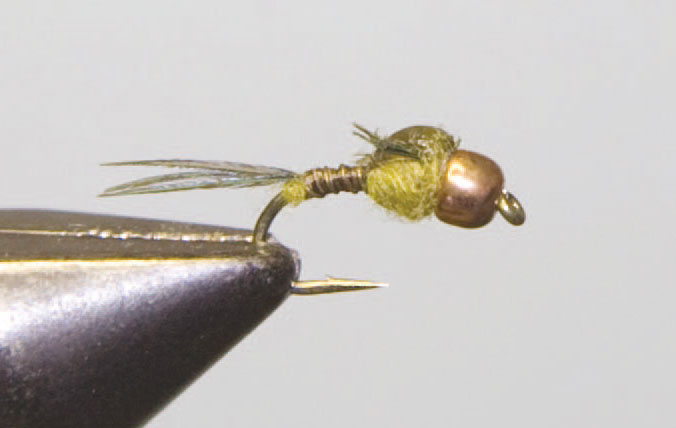
Mike Mercer’s Micro May
Hook: Tiemco 3769 sizes 14 to 18
Bead: Copper bead, sized a bit larger than normal
Thread: 8/0 Uni-Thread, color to match fly
Tail: Ringneck pheasant fibers, color to match fly
Rib: Small wire, silver or copper, to complement fly color
Abdomen: Stripped peacock herl
Wing Case: Turkey tail
Wing Case Strip: Pearl Flashabou
Thorax: Dubbing to match fly color (brown, olive, black)
Legs: Ringneck pheasant fibers, color to match fly
Collar: Dubbing to match fly color
I carry Micro Mays in sizes 14 to 16 in olive, brown, and black, with the small olives getting the most action in the fall. As I mentioned previously, it is one of my favorite flies fished as a dropper off a dry, particularly as the last fly in a dry, copper, dropper rig. I also nymph with it in a two nymph rig, both with and without an indicator, on almost all rivers that hold trout in Northern California. It has accounted for some surprisingly large fish, including the largest trout I have ever seen on the lower Sacramento, a fish in excess of 10 pounds that ate a size 16 fly.
I also fish Micro Mays for steelhead in nymphing rigs, particularly when fish are holding in deep, slow, crystal-clear runs and have become highly selective or even “stale.” This has more than once saved the day. I prefer to tie these patterns on a size 14 or 16 hook that is 4X strong — a Mustad R90 — to prevent the hook from opening and losing a hard-earned fish. For both steelhead and trout, I allow this fly to swing up at the end of a dead drift and then give it a few twitching retrieves to beg a dance when no other approach seems to turn the trick.
The Prince Nymph
The Prince Nymph is another versatile nymph pattern that has its place in my trout box year-round and in my steelhead box in season. I carry it in sizes 8 to 18 with bead heads and in sizes 10 to 16 without. I have come to prefer Fred Gordon’s version, which has amber-colored biots for the tail and wings. It is a bit more subdued than the standard white-winged versions, and the fish seem to appreciate this aesthetic. Fred is a local artist, fellow guide, and good friend, which also gives me a good feeling about fishing it.
If there is such a thing as an attractor nymph, this pattern would be it. It generally imitates a fair number of underwater critters that trout like to eat, though no one critter in particular. In the fall, fish might take it for an October Caddis case or Isonychia mayfly in the larger sizes, for an immature stonefly or caddisfly in the medium and small sizes, and as a mayfly nymph in the tiny sizes. Or perhaps they just mistake it for a snack — a chip, cracker, or cookie that looks tasty.
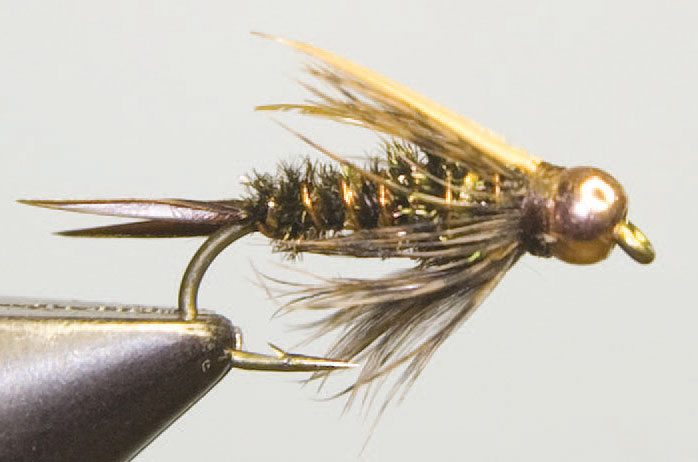
Prince Nymph
Hook: Tiemco 3761, sizes 8 to 18
Bead: Gold (copper for Gordon Prince)
Thread: Black 6/0 Uni-Thread, or 8/0 in small sizes
Tail: Brown turkey or goose biots (amber for Gordon Prince)
Rib: Gold tinsel, fine
Underbody: Black dubbing
Body: Peacock herl
Legs: Brown hackle
Wing: White turkey or goose biots (amber for Gordon Prince)
On nymphing rigs for trout, a Prince Nymph most commonly finds its place as the upper fly in a two fly-rig, with a smaller beadhead nymph such as a Pheasant Tail, Bird’s Nest, Micro May, or the like below. I most often dead drift it with or without an indicator, but let the fly lift up at the end of the drift and retrieve it in shorts strips to mimic swimming insects before casting again.
When nymphing for steelhead, most locals’ standard terminal tackle is a “legs and eggs” rig — a Rubberlegs pattern and a Glow Bug. If I decide to take off the Rubberlegs or egg pattern, I usually replace it with a Prince Nymph. A surprising number of fish will eat this fly as it lifts and swings at the end of a drift. This has become so effective at times that I occasionally swing a Prince-style wet fly with a switch rod. As with the Micro Mayfly, I tie this pattern on a heavy hook. I discovered the hard way that a size 8 or size 10 Prince Nymph tied on a 2X-strong hook will bend open under the pressure of a sizeable steelhead, so now I prefer to tie them on steelhead-grade hooks to avoid suffering the same fate.
The Klamath Classic
My standard choice for swinging a wet fly in the fall is one that I call the Klamath Classic. There are many classic flies that folks have been fishing on the West Coast for as long as anglers have been casting flies for steelhead. Some of the standards include the Silver Hilton, Skunk, Green Butt Skunk, and the Purple Peril, although some folks have a new favorite — the Paris Hilton. The pattern that I now use most is based on all of these flies, but was inspired by Dec Hogan. I read Dec’s book, A Passion for Steelhead, and met him when he returned home to Northern California to present a program to the Shasta Trinity Fly Fishers, a Redding fly-fishing club. In a chapter on flies, he describes his favorite summer fly, which he calls the No Name Summer Fly.
Dec explains that while the ingredients for his recipe remain similar for each No Name fly, every fly will be a bit different from the previous one. The fly will most often have a tail, a body of dubbing or chenille, some ribbing, a hair or feather wing, a hackle, and a thread head. The materials and colors are up to the creativity of the tyer.
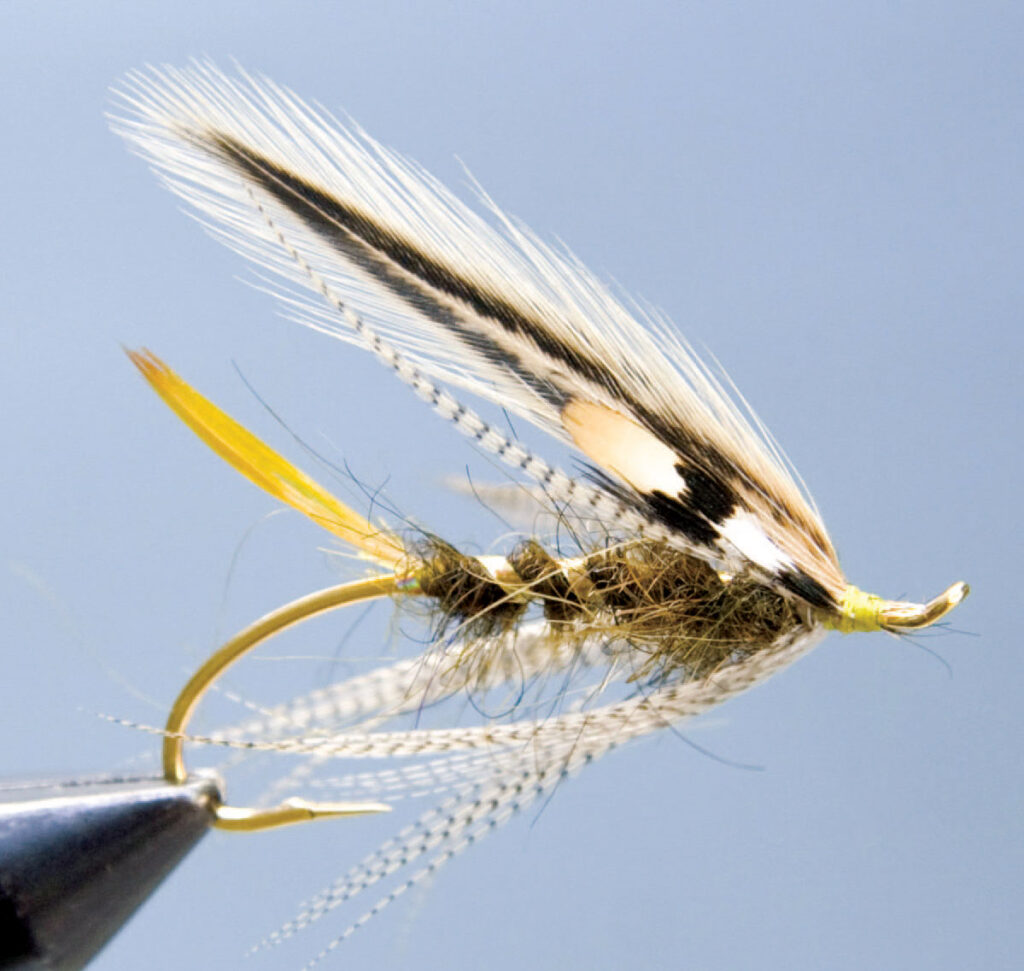
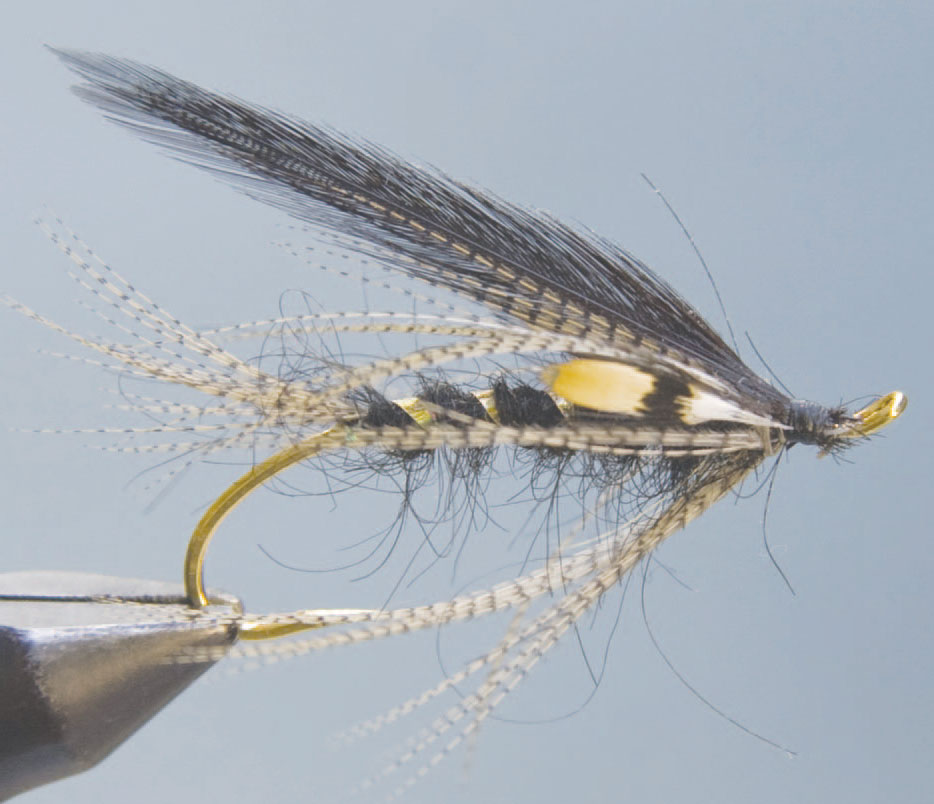
Klamath Classic
Hook: Tiemco 7999 or 202SP
Thread: 6/0 Uni-Thread, color to match or complement fly
Tail: Hackle fibers or pheasant crescent feather
Rib: Tinsel, color of choice
Body: Chenille or dubbing, color of choice
Hackle: Rooster, hen neck, or duck flank
Wing: Paired rooster or hen feathers, or polar bear substitute, color of choice
This concept has prompted a renaissance in my tying. I began tying early in my fly-fishing career and actually sold some of my creations while in my early teens, and more recently, as a guide, I would tie flies for myself and my family, as well as for guests, if I could not find them at a fly shop. For a guide, though, tying flies becomes a chore. The task most often involves tying as many well-made flies as quickly as possible so I can turn in and get some sleep before getting an early start guiding the following day. However, I now enjoy tying steelhead flies, and in particular, my Klamath Classic, which I’ve named after the where river I fish for steelhead most frequently.
I tie the fly on size 4 to 10 steelhead hooks. Each has a tail, perhaps a tag, a body of dubbing, herl, floss, or chenille, a hair or feather wing, a few turns of hackle, a thread head, and if I really like the way the fly turned out, I might even include jungle cock eyes. I often tie a fly with an overall objective — say a big, bright fly or small, drab fly — or when I find a material new to me and design a fly to incorporate it. While the steelhead may not fully appreciate the aesthetics, enough of them usually do that the added creative aspect makes my fishing more enjoyable.
The preferred method is to fish these flies a bit below the surface, using a floating line and long leader, casting quartered downstream and swinging them across likely steelhead holding water. As fall progresses and water temperatures drop into the low 50s and 40s, fish often become reluctant to move up to eat a fly, and I use light sink tips to run the flies deeper in the water column. I most often fish as far upstream on the Klamath and southern Oregon steelhead streams as steelhead can travel, so they have seen a number of anglers and their flies on the journey. While the techniques I use are the same as many of these anglers, the fly I use is unique, sparking what I hope is a bit of curiosity to entice a grab. If not, at least I am casting a fly I enjoyed tying.
The Muddler Minnow
If there is something more exciting in our sport than seeing an adult steelhead take a dry on the surface, I have yet to experience it. I feel very fortunate that in our part of the world, the annual cycle brings us the magical, elusive steelhead. In the late summer and early fall, some of them are willing to rise to a waked or skated fly.
Fish are willing to take flies on the surface when water temperature ranges from the low 50s through the mid 60s, and when water clarity is good enough for the fish to see the surface easily. I fish a Muddler attached to a floating line and long leader of 10 to 15 feet, tapered to 6-pound or 8-pound test. The cast is made across and downstream (how much downstream depends on the current speed), with subsequent mends to find the perfect steady speed across the current to entice a grab. This is an ideal technique for those new to swinging flies for steelhead, because the swing is so visual, allowing anglers to understand quickly how the angle of the cast and the mending of the line affect the speed of the swing. I prefer two-handed rods and have been fishing switch rods in this style since the 1980s. I cast them both one-handed and two-handed overhead, as well as Spey style.
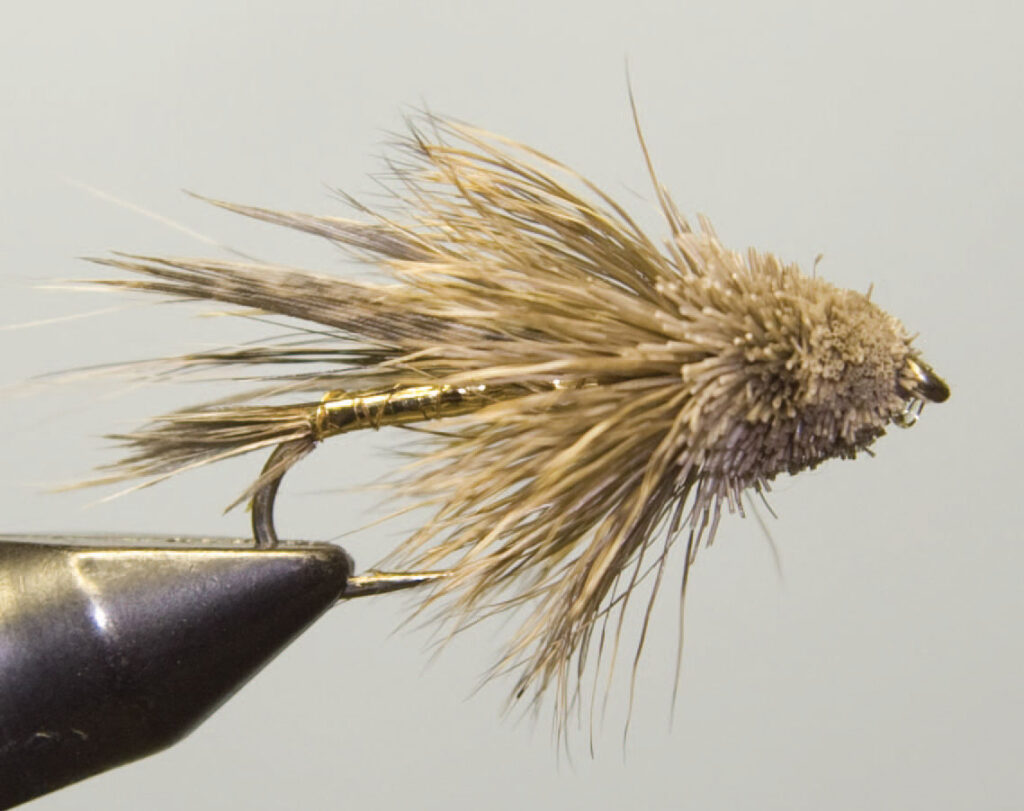
Muddler Minnow
Hook: Tiemco 5262 or 300, sizes 2 to 10
Thread: 6/0 Uni-Thread, color to match fly
Tail: Mottled turkey
Rib: Gold oval tinsel (optional)
Body: Gold tinsel or diamond braid
Wing: Mottled turkey over natural-color squirrel
Head: Spun deer hair clipped to cone shape, leaving some tips facing back to hook bend
The goal is to cover as much water as efficiently as possible in order to find a player. If a fish rises, but isn’t hooked, I give it another cast or two and then switch to a smaller dry. If that fails, I switch to a small Klamath Classic, then to a larger Klamath Classic, making a couple casts with each. I might add a short (10 foot) fast sinking tip and make a couple more casts with the large Klamath Classic or go back to the original Muddler that drew the rise and make a few more casts before continuing to move downstream through the run. On the second time through, I flick my rod tip, causing the Muddler to pop or chug, much like a bass popper, to try to tease the fish into striking. If this fails, I’ll mark the spot and return in my next fishing session, hoping the fish is in a more playful mood.
My Muddler fishing is not limited to steelhead in the summer and fall, though. Trout in our local freestone streams — the upper Sacramento, the Pit, and particularly the McCloud — will eat streamers, and the Muddler certainly has a place in my trout box. I have found Kelly Galloup’s version, which he calls the Zoo Cougar, to be particularly attractive to large brown trout on the McCloud. It is my go-to fly, particularly in any situation where a weighted streamer might hang on the bottom. I fish it attached to a fast-sinking tip with a short, 3-to-5-foot leader made of 0X with a 2X tippet. I use an open Loop Knot to allow additional life-like action. Kelly’s design generates more movement than conventional Muddlers, which enhances its attractiveness to trout.
Swinging the fly through riffles, around structure, and through the shallow heads and tailouts of runs will get some impressive fish to grab. I most often add short strips or tease the rod tip to add some action. Keep in mind that a goodly portion of the trout we catch with other methods will not be in the game when fishing this fly, because only the larger fish respond to these big bites. The simple formula that the more water you cover, the more fish you catch is doubly true with this method. This technique gets really exciting in the fall, when large browns can be sighted in the low, clear water, and you can watch them chase and eat. Do tie your knots with care.




